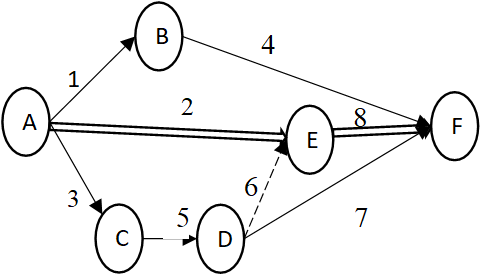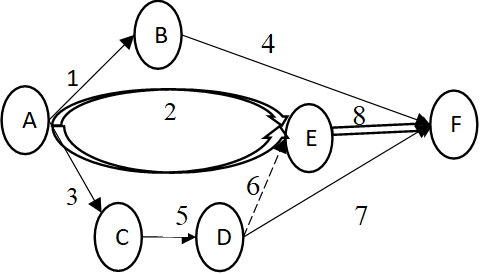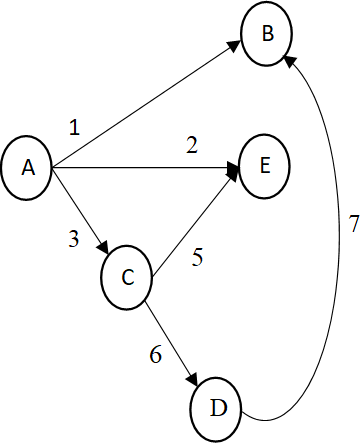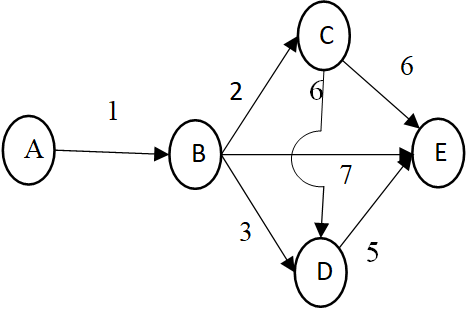This set of Industrial Management Multiple Choice Questions & Answers (MCQs) focuses on “Network Analysis – Set 3”.
1. From the given below statements, find the incorrect statement.
i. A critical path has zero float.
ii. A critical path has both critical and non-critical activities.
iii. A critical path is the longest path and consumes maximum time and resources.
a) i only
b) ii only
c) i and iii only
d) iii only
View Answer
Explanation: A Critical path always has zero float. Critical path will have only critical activities which upon delayed will delay the entire project. A critical path is the longest path and consumes maximum time and resources.
2. When an activity is called a critical activity?
a) When earliest start time (EST) is equal to the earliest finish time (EFT)
b) When earliest start time (EST) plus the time taken by it is equal to the latest finish time (LFT)
c) When latest start time (LST) plus the time taken by it is equal to the latest finish time(LFT)
d) When earliest start time (EST) plus the time taken by it is equal to the earliest finish time (EFT)
View Answer
Explanation: An activity is called critical activity if and only if the earliest start time (EST) plus the time taken by it is equal to the latest finish time (LFT). In other words, if an activity is delayed from the actual timeline and because of this if it affects the entire project duration, then the activity is known as a critical activity.
3. What is also called an arrow diagram?
a) Activity diagram
b) Project diagram
c) Network diagram
d) Scatter diagram
View Answer
Explanation: Network diagram is also known as an arrow diagram. It schematically shows the various events and activities in the order of which they need to be completed and their inter-relationships and inter-dependencies.
4. Match the following.
p) AOA i) Activity diagram q) AON ii) Network diagram r) Arrow diagram iii) PERT iv) CPM
a) p – ii, q – i, r – iii
b) p – ii, q – i, r – iv
c) p – iii, q – iv, r – ii
d) p – i, q – ii, r – iii
View Answer
Explanation: PERT network is known as AOA (Activity on arrow). CPM network is known as AON (Activity on Node). The arrow diagram is also known as a network diagram.
5. Among the given options, find AOA representation.
a)

b)

c)

d)

View Answer
Explanation: Upper case English alphabets are generally used to represent activities of a project in a network diagram. The below-shown diagram represents the AOA as it has an activity represented on the arrow.

Note: An event may also be represented by an ellipse or a square or a rectangle.
6. What of the following represents AON?
a)

b)

c)

d)

View Answer
Explanation: Upper case English alphabets are generally used to represent activities of a project in a network diagram. The below-shown diagram represents the AON as it has an activity represented on the Node.

7. Find the correct network diagram.
a)

b)

c)

d)

View Answer
Explanation: There are certain rules for drawing a network diagram. They are as follows:
i. Each activity should be represented by one and only one arrow.
ii. Two activities should not have the same start and end events.
iii. No two arrows should cross each other.
iv. Arrows should be straight and should not be curved.
v. The flow of arrows i.e., representation of arrows should always be forward only such that the flow of a network diagram is forward. In other words, the network diagram should not flow backwards.
vi. There should not be any cycles or loops or whirls in a network diagram.
vii. A dummy activity should be used in the arrow diagram if and only if the arrow diagram doesn’t sense to establish a logical relationship without a dummy activity.
viii. The network diagram should not have any activity disconnected except the last activity that completes the network diagram of the given project.
ix. Apart from the above-mentioned rules, there are certain rules known as FULKERSON’S 1-J Rule. According to it, the labeling of nodes in a network diagram should be sequential.
8. Calculate the earliest start time (EST) for an activity ‘A’ if the duration of the activity is 3 minutes and the earliest finish time (EFT) is 14 minutes.
a) 10 minutes
b) 11 minutes
c) 12 minutes
d) 14 minutes
View Answer
Explanation: We know that,
Earliest finish time (EFT) = Earliest start time (EST) + Duration of activity
14 minutes = EST + 3 minutes
EST = 11 minutes.
9. Find the latest finish time (LFT) when the latest start time (LST) and duration of the activity are 6 minutes and 4 minutes respectively.
a) 4 minutes
b) 9 minutes
c) 8 minutes
d) 6 minutes
View Answer
Explanation: We know that,
Latest finish time (LFT) = Latest start time (LST) + Duration of activity
LFT = 6 minutes + 3 minutes
EST = 9 minutes.
10. Match the following.
p) Negative float i) Just sufficient resources q) Zero float ii) Surplus resources r) Positive float iii) Inadequate resources
a) p – ii, q – i, r – iii
b) p – ii, q – iii, r – i
c) p – iii, q – i, r – ii
d) p – i, q – ii, r – iii
View Answer
Explanation: If the float is negative, the resources are inadequate and a necessary suitable corrective action needs to be taken to achieve in time project completion. It may be the allocation of additional resources or Crashing of the critical path. If the float is zero, then the resources allocated are just sufficient. If the float is positive, it indicates redundancy in the resources.
Sanfoundry Global Education & Learning Series – Industrial Management.
To practice all areas of Industrial Management, here is complete set of 1000+ Multiple Choice Questions and Answers.
If you find a mistake in question / option / answer, kindly take a screenshot and email to [email protected]
